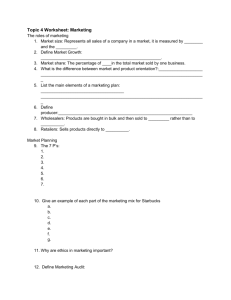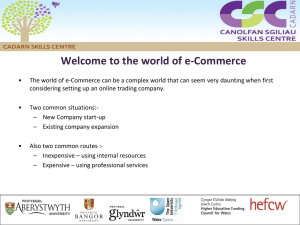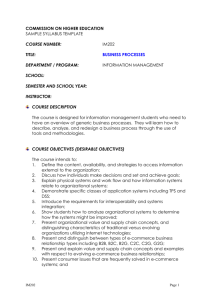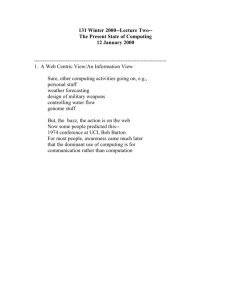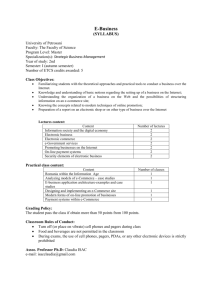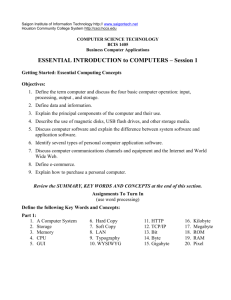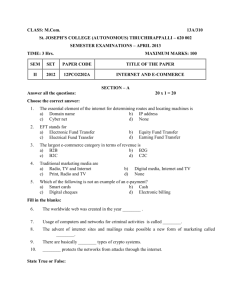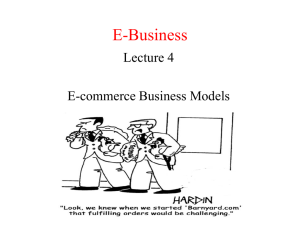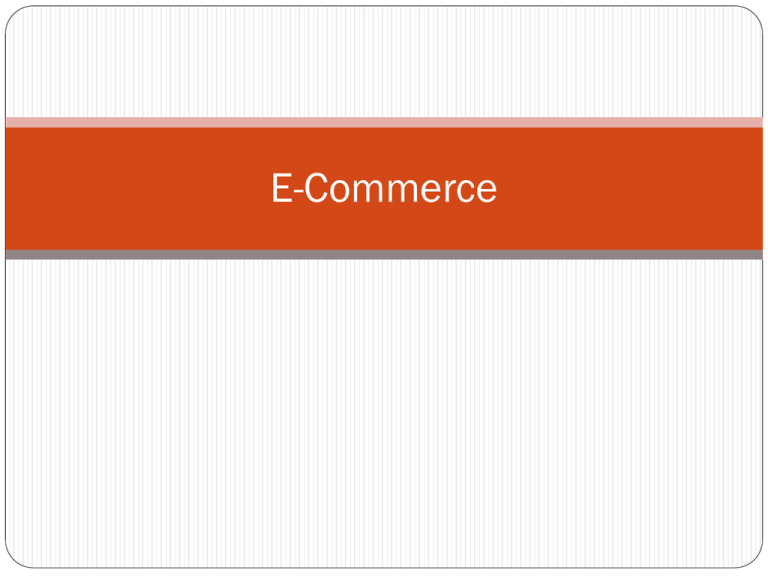
E-Commerce
Brief History
Early 1970s saw introduction of Electronic Fund Transfers (EFT)
Limited to large organisations, financial institutions, few daring small
business
Late 1970s and early 1980s – Electronic data interchange(EDI)for e-commerce
within companies
Used by businesses to transmit data from one business to another
to include other transaction processes besides financial; included
manufacturers, retailers, services, etc
1990s- the World Wide Web on the Internet provides easy to use technology for
information publishing and dissemination
Cheaper to do business (economics of scale)
Enable diverse business activities (economics of scope)
Between 1997 and 2000, more than 12000 Internet-related business
were started
What is e-commerce?
"The conducting of commercial transactions (the exchange of
merchandise, services, information, and/or money between suppliers
and receivers for the commercial transfer of goods between economic
actors) through electronic mediation using Internet technology."
-Ministry of International Trade and Industry of Japan
What is e-commerce?
"Electronic commerce (e-commerce) is business transactions conducted over the
public and private computer networks. It is based on the electronic
processing and transmission of data, text, sound and video. E-commerce
includes transactions within a global information economy such as
electronic trading of goods and services, on-line delivery of digital content,
electronic fund transfers, electronic share trading, electronic bills of lading,
commercial auctions, collaborative design and engineering, on-line
sourcing, public procurement, direct consumer marketing and after-sales
services. It involves the application of multimedia technologies in the
automation and re-design of transactions and workflows, aimed at
increasing business competitiveness."
- Inter-Agency Task Force on Electronic Commerce (IATFEC),
Malaysia
What is e-commerce?
From these two definitions, e-commerce simply means:
the implementation of business transactions through the
information superhighway using computer networks.
In other words, business transactions are conducted in
cyberspace.
To implement it, e-commerce requires new physical and
legal infrastructure (such as computer systems,
telecommunication network, and cyberlaws), new skills, new
workflows and new processes.
Buyer and Seller Roles In Commerce
6
Communication on the Web
Mass media
One-to-many model
Flows from one advertiser to many customers
Seller is active, buyer is passive
Personal contact
One-to-one model
Interchange within a framework of trust
Seller and buyer are active
7
Communication on the Web (cont.)
Web
Many-to-one/many-to-many model
Buyers can communicate with many sellers
Buyer actively searches, and controls the length, depth and
scope of the search
8
Communication Channels
9
Levels of Trust
10
Types of e-commerce
2 types of e-commerce:
B2C
B2B
B2G (business to government)
B2C
B2C means e-commerce transactions between business and
consumer
Commerce between companies and consumers
Involve customer gathering information; purchasing physical
goods (tangible such as books or consumer products) or
information goods (goods of electronic material or digitised
contents such as software or e-books
2nd largest and earliest form of e-commerce
Example of B2C business:
Retailing business: Amazon.com, pizzahut.com,
Information goods: cuticuti.com,
With the use of online banking tools (example: Maybank2u)
B2B means e-commerce transactions between business and
business
E-commerce between companies
Example: IBM, HP, Dell
B2G means e-commerce between companies and public
sector
involves borderless transactions.
Internet for public procurement,
Example: myeg.com.my, e-tender by JKR, licensing procedures
and other government related operation
Advantage/benefit to business
Help increase profits and decrease costs; reduced overhead; facilitates “pull”-type
supply chain management
Wide base for customers – internationally; geographically scattered; areas not
previously reached
Identify new suppliers and business partners
Ability to create highly specialised businesses
Lower communication costs
Buyers have wide range of choices of vendors and products
Availability 24/7
Competitive market causes decrease in prices, discounts or “freebies” thrown in
Customers receive relevant and detailed information in seconds, as opposed to days
or weeks
Allows individuals to work from home, do less travel
Disadvantage to business
Some businesses processes may not work using e-
commerce
Perishable goods
Difficult to calculate return-on-investment (ROI)
Potential cultural and legal obstacles
Legal environment still unclear and have conflicting laws
No “touch-and-feel” aspect
Loss of ability to inspect products from remote locations
E-commerce infrastructure
Information superhighway infrastructure
Internet, LAN, WAN, routers, etc
Telecom, cable TV, wireless, etc
Messaging and information distribution infrastructure
HTML, XML, email, HTP, etc
Common business infrastructure
Security, authentication, electronic payment, directories catalogs, etc
Web architecture
Client/server model
N-tier architecture; e.g. web servers, application servers, database
servers, scalabilty
The process of e-commerce
Attract customers
Advertising, marketing
Internet with customers
Catalog, negotiation
Handle and manage orders
Order capture
Payment
Transaction
Fulfillment (physical good, service good, digital good)
React to customer inquiries
Customers service
Order tracking
Issues Surrounding E-commerce
•Trust
•Language
•Culture
•Culture and government
•Infrastructure
Trust Issues
How do I know who you say you are?
How can I guarantee that you will supply me with the
products you offer within the timeframe you gave?
© The New Yorker Collection 1993 Peter Steiner from cartoonbank.com. All rights reserved
Trust Issues
Established companies, especially those with offline presence,
have easy time creating trust on the Web
New companies face difficulties due to anonymity that exists
Visitors won’t just buy from anyone, especially if they have
never heard of the company before
Language Issues
“Think globally, act locally”
Providing local language conversions of a site
Customers more likely to buy products or services from a site in
their own language
About 60% of content on Web is in English; more than 50%
of current Internet users do not read English
Culture Issues
Common language and common customs provide an easier
time for consumers to determine how companies will react
in situations of misrepresentation of quality, etc
Laws and business practices vary between countries
Culture Issues
Wine.com (not suitable for Muslim culture)
Use of icons and terms to depict common actions
Shopping carts used in US; shopping baskets used in Europe;
shopping trolleys used in Australia
The OK symbol seen as an obscene gesture in some countries
Culture and Government
Government controls that limit forms of open online
discussions
Some officials in North African and Middle East take public
issue with the availability of sexually explicit, anti-Islamic
content on the Web
Culture and Government
In 2004, Chinese government shut down a Blogbus
because it contained an essay which the government
deemed to contain “forbidden content”
French law regulates that an advertisement for a product
must be in French; companies willing to sell to
Frenchmen online and ship to France must have content
in French
What impacts do you see for these restrictions in
Malaysia where e-commerce is concerned?
Infrastructure Issues
Local connection costs in developing countries high; some
countries required payment for time spent online
This could lead to people spending less time online
Introduction of flat-rate access required
Check Tmnet promotion, W1max, Celcom and Maxis
broadband
More than half of businesses on web turn away international
orders as do not have capacity or processes in place to fill
them
Obstacle, problems and issue faced by
companies in engaging e-commerce
1.
Lack of awareness and understanding of the value of e-commerce
Many thinks that e-commerce suited only for big companies
Additional cost that will not bring any major returns to investment
2.
Lack of ICT knowledge and skills
Shortage of skilled workers especially in small and medium companies
Limited capabilities in design, distribution, marketing and post sale support
3.
Financial cost
Initial investment to adopt new technology is proportionately heavier for small than for
large firm
Firms will need to undertake investment in an appropriate computer system to implement
e-commerce.
High cost of computer and internet access
4.
Infrastructure
Many developing countries has poor telecommunication infrastructuren
5.
Security
Ensuring security on payment and privacy of online transaction
Lack of trust to use internet to make online payment
Impact of e-commerce
e-commerce will eliminate mediation process as producers can
sell direct to consumers.
firms will have fast knowledge of what customers want.
Firms can use this knowledge to guide the development of their
product lines and to identify new growth areas at their earlier
stages.
e-commerce will also help small- and medium-sized enterprises
(SMIs) to gain greater market reach for their products and
services.
Impact of e-commerce
In fact, e-commerce can be an efficient and economical way for
many SMIs to enter an export market.
E-commerce offers consumers a wide range of new opportunities
to do direct shopping and banking using the convenience of a
home computer or other communication devices.
Consumers will also benefit in terms of lower final prices due to
lower transaction costs as described above.
e-commerce consumers will have a wider and direct access to
producers of goods and services without intermediaries.
Impact of e-commerce
With a wider choice of products and services offered to them,
they can cast their preferences by describing what they want.
In this environment, e-commerce will hasten the shift of market
power of consumers, from a "product taker" to a "product
maker".
As a result, this process will lead to greater competition among
firms to protect their market share.
e-commerce will result in higher investment by the Government,
firms and consumers.
Impact of e-commerce
Coupled with higher investment in IT, e-commerce will
result in higher efficiency and productivity of the economy.
e-commerce will contribute to higher total factor
productivity of the Malaysian economy which is needed to
sustain economic growth in the long term.
E-commerce will create new activities and a variety of new
industries which utilize IT.
This will lead to the creation of new job opportunities.
Reference
Electronic Commerce, Seventh Annual Edition by Gary Schneider
Electronic Commerce: A Managerial Perspective by Turban, Lee, King and
Chung
Public Bank Economic Review. May 2000.

